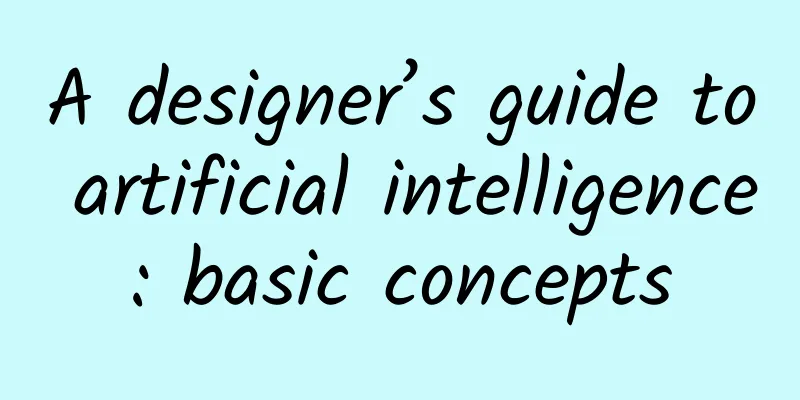A designer’s guide to artificial intelligence: basic concepts

|
When AlphaGo created by Google defeated the Go grandmaster, when Psibernetix of the University of Cincinnati defeated the fighter pilot, when the Internet era turned into the intelligent era, when the era began to migrate, those who did not keep pace with the era would eventually be eliminated by the era. So for the design field, what are the points of convergence with artificial intelligence? As designers, interactions, and product developers, how do we understand artificial intelligence? Welcome to follow this series, let's explore design and artificial intelligence together! PrefaceThe most familiar words for Internet practitioners in recent years are intelligence, algorithm, and AI. With the development of massive data storage and computing power, artificial intelligence AI has become a basic capability, widely used in structured data computing, natural language processing, computer vision and other fields. This series will focus on the basic capabilities of artificial intelligence AI and the intelligence of the design field. If you are a designer or product manager, you can learn the basic knowledge of getting started with AI, how artificial intelligence affects design and interaction, and grasp the "can" and "cannot" of intelligent design; if you are an algorithm or technology student, this series will not involve the sharing of cutting-edge algorithms, but you can also learn about some of our thoughts on intelligence in the field of design. AI x Design Artificial Design IntelligenceAs a basic capability, artificial intelligence (AI) is not intended to replace the work of traditional designers, but to improve and enhance design capabilities and efficiency through computer computing power (computing ability) and rules, and to turn machines into designers' assistants by allowing them to learn design. The breakthrough in design intelligence actually benefits from the introduction and popularization of AI algorithm framework (deep learning model). In recent years, design intelligence has been mainly used in design semantic extraction, style recognition, style transfer, design evaluation and recommendation, and design adversarial generation. For example, when the Xiaomi CC9 mobile phone was released, it introduced a feature called "Magic Sky Change". Users can take a photo with a sky background and it can be changed into various styles of sky, such as sunny, cloudy, night, etc. From the perspective of the interactive design presentation model, "changing the sky" is just a one-click switch of the "design style" on the user side. However, if we look at it from the perspective of the implementation model, we first need to implement semantic segmentation of images so that the machine can learn to distinguish what the sky is. Then, through the input of massive amounts of image data of different styles, the machine can learn what style is. In the process, different algorithm models will be applied, such as #convolutional neural network CNN# combined with #attention mechanism Attention Networks# to extract key features for style classification. Finally, the generative model and discriminative model of #generative adversarial network GAN# can be used to train and output the optimal target style image, thus completing the user's "magic sky changing" operation. There are many classic examples of design intelligence. As an interactive designer, the above algorithm model framework and implementation details may not be our focus. What we need to focus on is the capabilities and boundaries of AI algorithms, so as to think about how AI affects product interaction and user behavior. If you want to master the capabilities and boundaries of algorithms, you must not miss the following basic introductory concepts. The beauty of algorithms1. "What is an algorithm? How to use it?" In layman's terms, an algorithm is actually a mathematical formula, a finite and definite set of solutions or problem-solving steps. For an algorithm, input A and output B must be fixed, and the algorithm is only responsible for the output logic in the middle. For example, in order to calculate addition, subtraction, multiplication and division, the teacher summarized the multiplication formula; for another example, in order to allow users to receive goods faster, the distribution system developed a path planning optimization algorithm. In scenario applications, algorithms must be based on the pain points of a certain business scenario. In order to solve a certain type of business problem abstraction, the algorithm loses its meaning without the business scenario. While solving business problems, it is necessary to ensure the accuracy and completeness of the solution. These are also the two major evaluation indicators that algorithm colleagues usually use when delivering algorithm models: accuracy and recall (recall rate). Simply put, accuracy measures the proportion of accurate predictions when the algorithm model predicts a certain object or event; and recall judges the proportion of the objects or events to be predicted by the algorithm model. Accuracy first means more accurate, and recall first means more complete. No algorithm can be both accurate and complete at the same time. It can only be based on the business scenario and priority. However, in most e-commerce recommendation scenarios, more attention is paid to accuracy. 2. “Does the algorithm have supervision or not?” We just mentioned that an algorithm is a set of solutions under agreed input and output. In terms of the training and learning methods of the logical black box, it can be divided into supervised learning and unsupervised learning. Supervised learning means that we agree with the machine in advance on what is A and what is B, and the machine is trained and learned according to our standards; supervised learning requires that the input of the algorithm model must be manually processed in advance, that is, data labeling. Classic supervised learning methods include regression and classification. The regression equation in basic mathematics is actually a kind of supervised learning. Unsupervised learning, as the name implies, does not require us to define standards and rules. The algorithm will automatically train and learn through feature extraction. Unsupervised learning is generally implemented through clustering algorithms. 3. Summary An algorithm is a set of problem-solving steps with agreed-upon inputs and outputs. To allow a machine to learn to make judgments, you can teach it step by step (supervised), or let it learn on its own (unsupervised). Machine Learning vs Deep LearningIf algorithms are solutions to problems, machine learning and deep learning are more like problem-solving ideas and structures at different stages. 1. What is machine learning? Machine learning, in layman's terms, is to enable a machine to perform a task well through continuous trial and error and feedback. If a machine is to take the college entrance examination and its goal is to get first place, according to the idea of machine learning, the machine will answer all the history test questions, learn the connection between the test questions and the answers, and then continue to answer questions repeatedly to improve the accuracy, and finally take the test and get first place. In the above example, several key elements are involved: task T, performance metric P, and experience E. Task T is the ultimate goal of machine learning or algorithm, that is, to get the first place in the exam. Performance metric P is the benchmark for optimizing data structure or algorithm logic. Defining appropriate performance metrics is crucial for the efficiency and improvement of machine learning. The final experience E actually refers to historical data or effect data, that is, historical test questions and wrongly answered test questions. In the field of e-commerce, the classic people-goods matching recommendation algorithm can be described according to the above definition as a problem-solving process for more accurately recommending personalized products (T) to different users, and continuously improving the accuracy of recommendation results (P) through historical recommendation data and user behavior data (E). Summary: Machine learning is based on historical data, outputs prediction data through model learning and training, and then continuously optimizes and improves the prediction model based on feedback data. 2. What is the difference between deep learning and machine learning? Let's go back to our example. The college entrance examination will not only have objective questions, but also subjective questions. If we use machines to grade the essays this time, it will be difficult for traditional machine learning to analyze according to human thinking and writing logic. The emergence of deep learning enables machines to "think like humans". Through the establishment of bionic neural networks, machines can learn and understand the connections between complex things, and optimize their own network structure by perceiving the outside world. In other words, the deep learning model is actually a type of machine learning, but the learning method has changed to mining sample data features by building a multi-layer perception structure similar to the human brain neural network structure, as well as combining and vectorizing low-dimensional features, thereby establishing a correlation between data and results. To better understand deep learning and neural networks, we must first understand how the human brain perceives and understands information (data). The network diagram in the middle is an abstract representation of the human brain structure. Each circle represents a neuron, and each arrow represents a group of synapses. Information enters from the input layer on the left, propagates through several hidden layers and synapses with different weights, and is output from the output layer on the right. Synapses with different weights will filter or strengthen information of different priorities, thereby guiding human actions. Based on the neural network structure of the human brain, the deep learning model first converts high-dimensional sparse features into low-dimensional dense features through Embedding vectorization, then retains important features through the hidden layer, and then uses the loss function Loss of the output layer to determine whether the training error meets the output requirements, and finally completes the model output. Compared with machine learning, the biggest breakthrough of deep learning lies in data feature mining, which is the process of feature vectorization. Therefore, deep learning frameworks are generally used in complex unstructured data scenarios. For example, speech recognition ASR, text processing NLP, image recognition CV, etc. are typical application scenarios. Summary: Machine learning is a method to achieve artificial intelligence, and deep learning is a technology for machine learning. Product interaction and algorithm boundaries Algorithms and machine learning are actually ways to solve problems. The effectiveness of algorithms in solving problems depends largely on the abstraction and transformation of business problems in the early stages. Therefore, for product or interaction students, the key is to understand the boundaries of algorithm technology capabilities, based on the analysis of business scenarios and needs, transform business problems into algorithm problems, and find the most suitable and efficient algorithm framework to achieve business goals. At the same time, in the process of product interaction design, the education cost of human-computer interaction should be reduced as much as possible, so that the performance model is close to the user's psychological model. Summarize An algorithm is a set of problem-solving steps that specifies input and output. There are two different algorithm frameworks: machine learning and deep learning. For different algorithm models, product interaction colleagues are more concerned about what problems the algorithm can solve and how to achieve product intelligence with more humanized interaction logic to reduce the cost of algorithm application. |
Recommend
Electric Technology Car News: Can Skoda Octavia emerge as a dark horse in the station wagon field, crushing Weiling and competing with Golf?
When we talk about station wagons, we often add k...
Google internal summary of the reasons for Google+'s failure: mobile layout was too slow
[[142560]] Google announced on Monday that users ...
11 types of locks and performance comparison in iOS development
[[221143]] In daily development, we often use mul...
3 strategies for native advertising!
Only by using fewer "tricks" can you tr...
Zhihu operation and promotion: the optimal solution for Zhihu recommendation algorithm!
I want to tell everyone: Don’t just focus on Baid...
iOS apps are banned from being "free" and Apple did not explain why
Now, if the word "free" appears in the n...
Once in a thousand years! The brightest gamma-ray burst to date, how did the "Insight" and "Jimu" jointly capture it?
At 2 a.m. on March 29, scientists from China, the...
Attention! These two common foods may increase the risk of colorectal cancer, Chinese scholars have recently found
The 2020 China Cancer Statistics Report shows tha...
The mint you eat is not real mint?
Review expert: Shen Tingting, Ph.D. in Botany As ...
The candlelight flickers like a dancing elf, a monologue of the Sony LSPX-S2 crystal sound tube, a desktop artwork
Ten years ago, Sony created the design concept of...
Case solved! Movie theaters generally have red seats because of this...
When watching a movie, have you ever noticed the ...
Can gray hair turn black again? The doctor's answer is unexpected
I believe that not many people like their gray ha...
The light "shines" and the wind "blows" and the "crackling" sound! Don't you want to know how to play with energy in the future?
Children in the future may see snow in winter, bu...
Marketing must-read: Limited-time flash sales operation and influencing factors
Limited-time flash sales are a marketing applicat...
Here are seven key points about APP message push
So, how to build a good APP message push mechanis...









